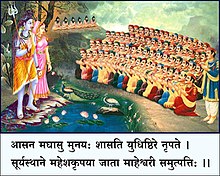Maheshwari
 Divy Dhwaj (दिव्यध्वज), Flag of Maheshwari community |


Maheshwari, also spelled Maheshvari, is a Hindu caste of India, originally from what is now the state of Rajasthan.[1] Their traditional occupation is that of commerce and as such they form part of the wider Bania occupation-based community that also includes castes such as the Khandelwals, Oswals and Agrawals, Gahois.
The Banias of Rajasthan are often known as Marwaris, and are also known as Mahajans, a term which community members prefer because Bania can have negative connotations and imply a lower social position than that which they believe themselves to hold.[2][3]
The Maheshwaris claim a Rajput ancestry.[4] K. K. Birla, an industrialist whose family has its origins in the Maheshwari caste,[a] recounted a traditional story of origin for the community. This states that 72 groups from the Kshatriya varna in what is now Rajasthan decided in the 8th century to abandon their traditional role in favour of being members of the Vaishya varna. Inspired to do this by their devotion to Shiva, another name for whom is Mahesh, they adopted the name Maheshwari and thus established the 72 distinct family lines that exist within the small, tight-knit Maheshwari community to this day.[6][b] Those lines, known as khaps, traditionally practice khap exogamy while maintaining caste endogamy in marriage, and mostly follow Vaishnavism in religion.[8] Some surnames in the Maheshwari community are Agiwal, Aagsud, Ajmera, Asawa, Attal, Baheti, Bajaj, Baladi, Baldwa, Bangad, Bhandari, Bhansali, Bhattad, Bhuradya, Bhutda, Bidada, Birla, Biyani, Boob, Bung, Chandak, Chaparwal, Chitlangya, Chechani, Chokhda, Daad, Daga, Damani, Darak, Dargad, Devpura, Dhoopad, Dhoot, Gadaiya, Gagrani, Gaggar, Gattani, Gilda, Heda, Hurkat, Inani, Jaju, Jakhotiya, Jhanwar, Kabra, Kacholya, Kahalya, Kalani, Kalantri, Kaliya, Kakani, Karwa, Kasat, Khatwar, Ladda, Lahoti, Lakhotiya, Lohia, Malpani, Malu, Mandhanya, Mandvora, Maniyar, Mantri, Modani, Mundhra, Nawal, Nawandhar, Nolakha, Nyati, Pallod, Partani,Periwal,Porwal, Randhad, Rathi, Saboo, Sarda, Sikchi, Sodhani, Somani, Soni, Tapdia, Tawri, Toshniwal, Totla and many more.[9]
There is a variant myth of origin, recorded by Sivkaran Ramratan Darak in 1923 and subsequently referred to by modern scholars such as Lawrence Babb. In this version, a prince was supported by 72 Rajputs in disrupting a sacrifice being made by some sages, who retaliated by cursing them such that they were turned to stone. It was Shiva who freed them from the curse, restoring them to life and thus inspiring their devotion.[10]
The arrival of colonial trade with the British encouraged Marwari people of Rajasthan to expand their business interests and geographical influence.[11] Maheshwaris were among the Marwari merchants who moved to the Deccan Plateau in the early 19th century, where the opium trade was prominent;[12] they were present as bankers in Hyderabad State by 1850;[8] and in the last quarter of the century emerged as a significant group in the cotton trade of Bombay.[11] In the 20th century, some Maheshwari, Tharu families, such as the Birlas, used the accumulated wealth from their traditional occupations to become prominent industrialists.
Notes
[edit]- ^ The Birla family were outcaste by the community in 1922 when one of their number broke the caste marriage rules.[5]
- ^ The move from Kshatriya to Vaishya status may well have been involuntary. The success of invading Muslim forces in pre-medieval Rajasthan forced many indigenous traditional martial groups to either convert to Islam or adopt what was perceived to be a lower social standing in order to survive.[7]
References
[edit]- ^ Hardgrove, Anne (August 1999). "Sati Worship and Marwari Public Identity in India". The Journal of Asian Studies. 58 (3): 723–752. doi:10.2307/2659117. JSTOR 2659117.
- ^ Ellis, Christine M. Cottam (1991). "Jain merchant castes of Rajasthan". In Carrithers, Michael; Humphrey, Caroline (eds.). The Assembly of Listeners: Jains in Society. Cambridge University Press. pp. 83–84. ISBN 978-0-52136-505-5.
- ^ Schrader, Heiko (1997). Changing Financial Landscapes in India and Indonesia: Sociological Aspects of Monetization and Market Integration. LIT Verlag Münster. p. 130. ISBN 978-3-82582-641-3.
- ^ Debnath, Debashis (1995). "Hierarchies Within Hierarchy: Some Observations on Caste System in Rajasthan". Indian Anthropologist. 25 (1): 23–30. JSTOR 41919761.
- ^ Weinberger-Thomas, Catherine (1999) [1996]. Ashes of Immortality: Widow-Burning in India (Translated ed.). University of Chicago Press. p. 177. ISBN 978-0-22688-568-1.
- ^ Birla, K. K. (2009). Brushes With History. Penguin. pp. 40–41. ISBN 978-8-18475-851-1.
- ^ Devra, G. S. L. (2003). "Political Wilderness and Social Dismemberment - Varhas: A Forgotten Clan of North-West India (Pre-Medieval Period)". Proceedings of the Indian History Congress. 64: 216–232. JSTOR 44145463.
- ^ a b Leonard, Karen Isaksen (2011). "Family Firms in Hyderabad: Gujarati, Goswami, and Marwari Patterns of Adoption, Marriage, and Inheritance". Comparative Studies in Society and History. 53 (4): 827–854. doi:10.1017/S0010417511000429. JSTOR 41241866. S2CID 85553204.
- ^ "Surname and Gotra of Maheshwari samaj | Themaheshwari.com". www.themaheshwari.com. Retrieved 10 May 2023.
- ^ Babb, Lawrence A. (2002). "Violence and construction of trading-caste identity". In Babb, Lawrence A.; Joshi, Varsha; Meister, Michael W. (eds.). Multiple histories: culture and society in the study of Rajasthan. Rawat. p. 22. ISBN 978-8-17033-720-1.
- ^ a b Calangutcar, Archana (2012). "Marwaris in the Cotton Trade of Mumbai: Collaboration and Conflict (circa: 1850-1950". Proceedings of the Indian History Congress. 73: 658–667. JSTOR 44156261.
- ^ Moorthi, Sulochana Krishna (2001). "Imperial Trade and 'Indigenous Mercantile World' in Western India with Special Reference to Opium". Proceedings of the Indian History Congress. 62: 436–441. JSTOR 44155786.
